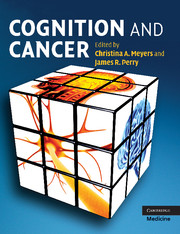Book contents
- Frontmatter
- Contents
- List of contributors
- Preface
- Section 1 Cognition and the brain: measurement, tools, and interpretation
- Section 2 Effects of cancer and cancer treatment on cognition
- 7 Biological bases of radiation injury to the brain
- 8 Cognitive dysfunction related to chemotherapy and biological response modifiers
- 9 Effect of hormones and hormonal treatment on cognition
- 10 Low-grade gliomas
- 11 High-grade gliomas
- 12 Brain metastases
- 13 Primary central nervous system lymphoma
- 14 Childhood brain tumors
- 15 Neurofibromatosis
- 16 Hematological malignancies
- 17 Paraneoplastic disorders
- 18 Symptomatic therapies and supportive care issues
- 19 Animal models and cancer-related symptoms
- Section 3 Interventions and implications for clinical trials
- Index
- Plate section
- References
10 - Low-grade gliomas
Published online by Cambridge University Press: 13 August 2009
- Frontmatter
- Contents
- List of contributors
- Preface
- Section 1 Cognition and the brain: measurement, tools, and interpretation
- Section 2 Effects of cancer and cancer treatment on cognition
- 7 Biological bases of radiation injury to the brain
- 8 Cognitive dysfunction related to chemotherapy and biological response modifiers
- 9 Effect of hormones and hormonal treatment on cognition
- 10 Low-grade gliomas
- 11 High-grade gliomas
- 12 Brain metastases
- 13 Primary central nervous system lymphoma
- 14 Childhood brain tumors
- 15 Neurofibromatosis
- 16 Hematological malignancies
- 17 Paraneoplastic disorders
- 18 Symptomatic therapies and supportive care issues
- 19 Animal models and cancer-related symptoms
- Section 3 Interventions and implications for clinical trials
- Index
- Plate section
- References
Summary
Introduction
Low-grade gliomas (LGG) are diffusely infiltrating primary tumors of the cerebral hemispheres, and originate from glial tissue (Kleihues & Cavanee, 2000). Patients with these tumors, like any patient with a brain disease, may experience cognitive complaints and have cognitive deficits on examination. In LGG patients, who usually have a paucity of neurological deficits, these cognitive complaints and deficits may be particularly prominent, in contrast to patients with high-grade gliomas (HGG). In HGG patients, the rapidly growing tumor typically gives rise to hemiparesis or increased intracranial pressure, which may overshadow more subtle cognitive deficits (Ashby & Shapiro, 2004; Rees, 2002). Moreover, LGG patients have a relatively good prognosis with median survival rates ranging from 5 to more than 15 years. Long-term-surviving LGG patients run the risk of late toxicity of treatment. Tumor and treatment effects may impair cognitive functioning in these patients during the course of their disease and have a deleterious impact on the quality of life of the patient and their family.
Epidemiology and biology, pathology and genetics, clinical and imaging features, prognostic factors in LGG
Epidemiology and biology
The percentage of low-grade tumors amongst gliomas, the most common primary brain tumor, ranges between 15% and 20% (Kleihues & Cavanee, 2000). The incidence of gliomas in adults is 5 to 7 per 100 000 (Bondy & Wrensch, 1996). This figure has remained stable for many years, unlike that of other brain tumors such as primary central nervous system (CNS) lymphoma, which is increasing in incidence.
- Type
- Chapter
- Information
- Cognition and Cancer , pp. 142 - 155Publisher: Cambridge University PressPrint publication year: 2008
References
- 3
- Cited by



